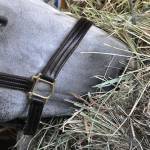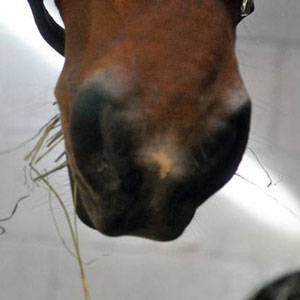Hay or Haylage: Dust Exposure, Lung Inflammation in Horses

Asthma hits athletic horses hard, sometimes affecting performance so much that they must retire from competitive sport. Exposure to environmental contaminants, which often originate from hay and bedding, remains a trigger for horses susceptible to asthma. Because of this, scientists at Purdue University recently hypothesized that high-performance horses fed haylage would have healthier respiratory tracts than those fed traditional hay.*
For this six-week study, researchers selected seven healthy Standardbreds. Baseline physical examination, hematology, and bronchoalveolar lavage were performed on the horses. Researchers randomly allocated the horses to one of two groups, one fed alfalfa hay and one fed grass-alfalfa haylage. All forage was fed on the ground. The horses were housed in the same facility and bedded on wood shavings, and all were trained using the same exercise protocol. Researchers performed physical examinations and bronchoalveolar lavages at weeks two, four, and six. Cytology was performed on lung fluid samples. Researchers measured dust exposure at the breathing zone of each horse on two occasions between weeks four and six.

What is Haylage?
Haylage is a conserved forage best described as a hybrid of hay and silage. The forage is cut and allowed to dry to about 65% moisture and then packed into airtight plastic. Haylage is fed in the U.S., but its use is more prevalent in other parts of the world, especially Europe. Although there is some risk associated with feeding haylage, primarily ingestion of the Clostridium botulinum toxin, vigilance when feeding can decrease the potential threat. Horse owners should discard any haylage that looks moldy or otherwise suspicious, and should consider vaccination against Clostridium botulinum serotype B. While vaccination against botulism is currently not a core vaccine in horses, consult a veterinarian about its possible use when feeding haylage.
In this pilot study, researchers found that feeding haylage to horses during training resulted in a lower exposure to respirable dust and organic compounds when compared to horses fed dry hay. The haylage-fed horses also had fewer neutrophils in the bronchoalveolar lavage fluid after two weeks in the study. Neutrophils are a type of white blood cell that indicate possible inflammation or infection. Because of the low number of horses included in the study, the researchers expressed the need for subsequent studies using more horses in field conditions.
Diagnosis of asthma is typically based on clinical signs (poor performance, chronic coughing), endoscopy findings (mucous accumulation in the trachea), and airway cytology. Treatment centers on control of airway inflammation, often through the use of systemic and inhaled corticosteroids. Another way to curb the inflammatory response is through the supplementation of polyunsaturated omega-3 fatty acids, particularly docosahexaenoic acid (DHA). A research-proven marine-derived source of DHA is EO-3.+
*Olave, C.J., K.M. Invester, L.L. Couetil, J.E. Kritchevsky, S.H. Tinkler, and A. Mukhopadhyay. 2021. Dust exposure and pulmonary inflammation in Standardbred racehorses fed dry hay or haylage: A pilot study. The Veterinary Journal 271:105654.
+Nogradi, N., L.L. Couetil, J. Messick, M.A. Stochleski, and J.R. Burgess. 2015. Omega-3 fatty acid supplementation provides an additional benefit to a low-dust diet in the management of horses with chronic lower airway inflammatory disease. Journal of Veterinary Internal Medicine 29:299-306.








